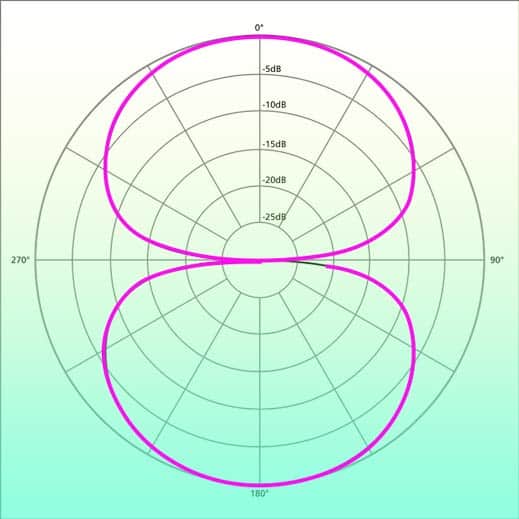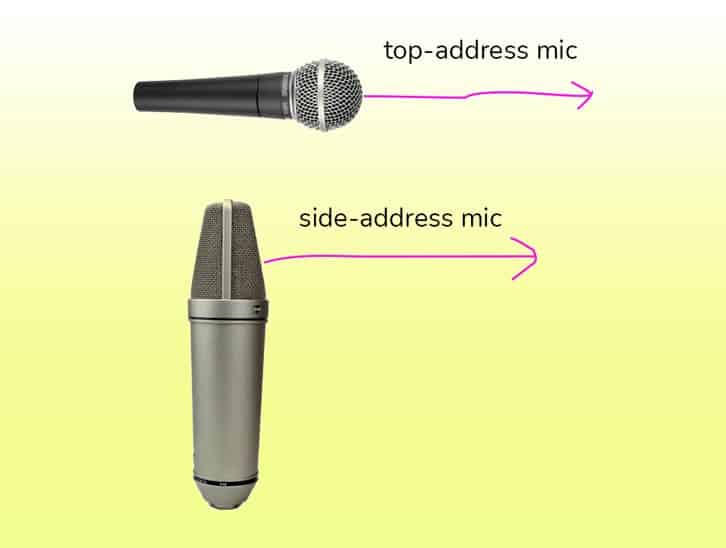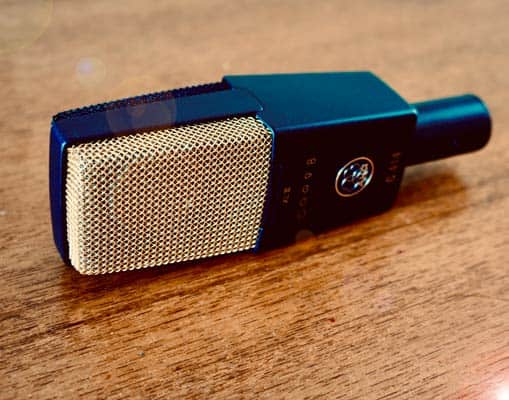Understanding the intricacies of microphone polar patterns (also known as pickup patterns, or directionality) is key to getting the most out of your mic.
Polar patterns refer to the microphone’s sensitivity to sound from different angles. If you understand the nuance of these angles on your particular mic, you can eliminate some of the guesswork in recording.
See here for more on understanding microphones and our category page for audio gear reviews.
What are Microphone Polar Patterns?
Let’s begin by understanding the fundamental principles of polar patterns. A polar pattern determines the microphone’s sensitivity to sound from various directions, enabling you to capture specific audio sources while minimizing unwanted background noise or interference.
Our ears pick up sound from all directions and our brains allow us to focus on a particular direction. In the case of microphones, the hardware usually has a built-in directionality.
Polar patterns allow you to effectively choose the area or areas of a room that you want to record.
One of the most important aspects of understanding polar patterns is, as we will discuss, the polar pattern of your mic will be different at different frequencies.
Deciphering the Polar Pattern Diagram: A Visual Guide
Here is a typical polar pattern diagram, with the most common polar pattern, cardioid:

0° represents the front and the angle of maximum sensitivity. 270° and 90° are the sides of the mike, and 180° is the rear. The circular scale consists of smaller circles, each denoting a 5 dB (decibels) decrease in sensitivity.
You’ll notice that the cardioid polar pattern has minimal sensitivity at the microphone’s rear. This characteristic makes the cardioid pattern an excellent choice for isolating desired audio sources and minimizing unwanted background noise.
The Big Three: The Most Common Polar Patterns
These are three pick-up patterns employed by most mics. You will find these terms in microphone spec sheets and polar pattern diagrams.
Cardioid (or Unidirectional)
The cardioid polar pattern, (shown above) best for most recording applications, picks up sound from the front. That means it has maximum sensitivity in the front and minimum sensitivity to the rear.
Why the weird term cardioid? It comes from the Greek ‘kardia’. Because it looks like a heart! Well, an upside down one.
Notably, the cardioid pattern excels in isolating dry signals, effectively minimizing undesirable room acoustics or background noise. This pattern is great for vocals or any close mic application.
Figure-8 (or Bidirectional)
The figure-8 polar pattern exhibits equal sensitivity to the front and rear, with minimal sensitivity to the left and right sides.

Our ears cannot really hear this way, entirely ignoring sound from the sides, which gives this polar pattern interesting characteristics. It is used in stereo recording techniques like mid/side or Blumlein.
It is great for getting dry recordings with a bit of bounce off a rear wall, with single instruments, or even an entire orchestra.
Most ribbon microphones are by default figure-8 in their polar pattern and multi-pattern condenser microphones usually have a figure-8 option.
Omnidirectional
Mics that have an omnidirectional polar pattern are sensitive to sound in all directions. Like it or not, they hear everything.

Caution must be exercised when recording in unfavorable acoustic environments. They will pick up all sorts of unwanted sounds. Also noteworthy, omnidirectional mics are not suited for live stage use.
But there are times when you’ll want this polar pattern. Omnidirectional mics excel in capturing the natural ambiance of acoustically pleasing rooms. They are great for recording orchestras, choirs, or ensembles of any size as well as drums, background vocals
Other Polar Patterns:
Supercardioid
A supercardioid mic is a more directional microphone compared to a cardioid mic. This is usually the standard pattern for shotgun mics. This pattern features slightly increased sensitivity on the sides and reduced rear rejection.
It’s shaped like a heart with a rear lobe attached.
This pattern proves advantageous in live settings, enabling high gain without feedback issues. It ensures a predominantly dry sound with minimal unwanted, neighboring noise.
Wide Cardioid
One more pattern you might come across is the wide cardioid pattern, a hybrid of the cardioid and omnidirectional patterns, the wide cardioid pattern combines the characteristics of both.
Wide Cardioid mics exist but they are rare. However, you will find that many omnidirectional mics employ a wide cardioid polar pattern at higher frequencies and cardioid mics employ a wide cardioid pattern at lower frequencies.
This is because microphones become more directional at higher frequencies and less directional at lower frequencies.
Engineers tend to use this pattern as a good balance between source and room ambiance. Wide cardioid pattern serves as an excellent choice for capturing smaller ensembles.
Why Polar Patterns are Different at Different Frequencies
A microphone’s polar pattern will be different depending on the frequency range. The process of capturing sound is not the same at all frequencies.
At higher frequencies, microphones become more directional. They exhibit a more focused response, capturing sound primarily from specific angles while rejecting sound arriving from other directions.
This increased directionality is attributed to the shorter wavelength of high-frequency sound waves. With a smaller wavelength, the microphone can effectively distinguish between sounds coming from different angles, resulting in improved directionality.
On the other hand, at lower frequencies, microphones tend to exhibit reduced directionality. With a longer wavelength, a microphone is less sensitive to sound arriving from a particular direction and more susceptible to picking up ambient noise from all around.
It is worth noting that these characteristics hold true for all microphones, regardless of their polar pattern.
To make this frequency-dependent pattern clear, polar pattern diagrams incorporate multiple frequency-specific patterns on a single graph, these illustrations enable a comprehensive understanding of how a microphone responds to sound from different angles across the frequency spectrum.
This is why some polar pattern graphs have multiple frequency-specific patterns. (like the pattern shown below of the Neumann TLM 103)

These graphs can be helpful in making informed decisions when selecting microphones for various applications.
Off-Axis Coloration Of Polar Patterns
In the world of microphones, the terms “on-axis” and “off-axis” play a significant roles in describing their directional characteristics. When we say a microphone is “on-axis,” we refer to its primary direction, typically represented as 0 degrees on a polar pattern graph. Conversely, “off-axis” refers to all other directions away from the primary axis.
Off-axis coloration is a term used to describe the variation between a microphone’s frequency response when measured on-axis and its actual frequency response when capturing sound off-axis.
In simpler terms, it explains the difference in sound quality when a microphone is pointed directly at the sound source versus when it captures sound from other angles.
Because polar patterns are frequency-dependent, when sound is captured from off-axis angles, the microphone may exhibit a slight roll-off or reduction in high-frequency content compared to when it is pointed directly at the source. This can result in a somewhat different tonal balance and perceived sound quality.
Off-axis coloration in a microphone is not necessarily a bad thing. Some microphones have more pronounced off-axis coloration, while others are more consistent. But quite often, especially in the case of some vintage microphones, this “flaw” of off-axis coloration, is exactly the sound that engineers and audiophiles have come to love.
Microphone Jargon: A Few More Terms Found in Polar Pattern Specs
Understanding polar pattern specifications enables you to make informed decisions while selecting the ideal microphone for your recording needs. Here are a few more terms you might come across:
Top-address / Side-address
Some mic capsules point out of the top of the body (like an SM58 or any pencil mic) and some point out of the side of the body (for example, the Neumann TLM 103 is a side-address microphone).
As you might imagine, top-address mics point out of the top of the body and side-address mics point out of the side of the body.

Most large-diaphragm condenser mics, tube mics, ribbon mics, and multi-pattern condenser mics are side-address microphones.
Most dynamic mics and small-diaphragm condenser mics are top-address microphones.
Rear Rejection
Rear rejection refers to the amount of signal reduction at the rear of the mic or 180°. A higher rear rejection ensures minimal sensitivity to sound coming from behind the microphone, thus enhancing isolation and focus on the desired audio source.
Side Rejection
Side rejection denotes the degree of signal reduction at the sides of the mic, or angles of 90° and 270°. Higher side rejection allows for effective suppression of off-axis sound sources, ensuring cleaner and more focused recordings.
Frequently Asked Questions
Which Polar Pattern is Best for Vocals?
When it comes to recording vocals, the cardioid polar pattern is the most popular choice. Its ability to capture sound predominantly from the front direction makes it ideal for intimate vocals, isolating and minimizing background noise.
However, with certain mics and situations other polar patterns might produce a more desirable result. Figure-8 or omni patterns, more obvious choices for live sessions or for recording in excellent acoustic spaces, give more room to the sound but with certain mics, more vocal presence.
If you’ve got a multi-pattern microphone, definitely experiment with the different polar patterns! As we have discussed, the frequency response of a microphone will be different with each polar pattern setting. You might find something you really like.
Which Polar Pattern is Best for Overhead Mics?
This is entirely dependent on what kind of space you are recording in. A matched pair of multi-pattern, large-diaphragm condenser mics would be an ideal set of mics for drum overheads (for example, two AKG C414 mics work well for drum overheads).
Having a multi-pattern set would mean you could experiment with the pattern and choose a setting depending on the space.
Which Polar Pattern is Best for Acoustic Guitar?
Generally, cardioid or super-cardioid is the pattern of choice. If you have a nice room with a nice bounce off the back wall, a figure-8 pattern can give some great results.
Check out our How to Record Acoustic Guitar for more ideas.
How are microphone polar patterns related to proximity effect?
Bidirectional mics have the strongest proximity effect, followed by cardioid mics. Omnidirectional mics have no proximity effect.
Questions or Comments?
Follow the discussion here on Facebook.



